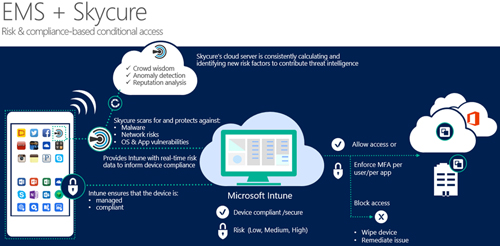News
Microsoft, Skycure Roll Out Intune Integration
- By Kurt Mackie
- March 29, 2017
Microsoft and Skycure, a mobile security firm based in Palo Alto, Calif., have partnered to integrate Microsoft's Intune mobile management service with Skycure's mobile device protection service.
The rollout is part of a collaborative effort in which Skycure's threat analysis service was integrated with the Microsoft Enterprise Mobility + Security (EMS) suite. EMS is a bundle of licensed Microsoft products offered under two plans. It includes licensing for Microsoft Intune, Azure Active Directory Premium, Azure Information Protection Premium, Microsoft Advanced Threat Analytics and Microsoft Cloud App Security.
Skycure announced the integration of its mobile threat analytics service with Microsoft EMS last month, but it was at the preview level back then. This week, Microsoft announced that the integrated Skycure and EMS offering had reached the "general availability" stage, meaning that it is deemed ready for use in production environments. Using the integrated service requires having EMS licensing in place and a Skycure Mobile Threat Defense subscription.
The integrated service permits IT pros to set rules based on risk levels or compliance regulations. The Skycure service uses "crowd-sourcing" techniques to detect threats. It will automatically or "dynamically" control user access based on those rules. The service offers protections against vulnerabilities, malware, physical device intrusions and network attacks, according to Skycure's announcement.
The Microsoft Intune service gets notified by the Skycure service of the device protections it carries out. Microsoft's announcement offered the following illustration of the process:
 [Click on image for larger view.] Skycure service integration with Microsoft Intune. (Source: Microsoft blog post.)
[Click on image for larger view.] Skycure service integration with Microsoft Intune. (Source: Microsoft blog post.)
IT pros can set conditional access policies based on the "Skycure risk assessment" within Microsoft Intune, according to Microsoft's documentation. The system relies on the use of mobile apps to gather telemetry, and works with Android 4.1 or later devices and iOS 8 and later devices. It will detect things like man-in-the-middle attacks when using public Wi-Fi access points or network threats associated with SharePoint Online access.
About the Author
Kurt Mackie is senior news producer for 1105 Media's Converge360 group.